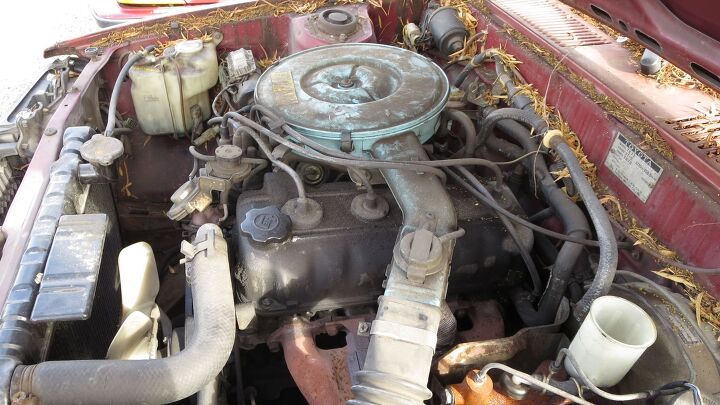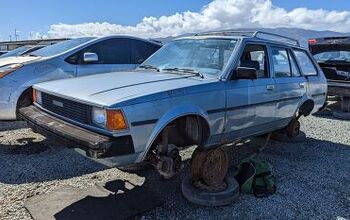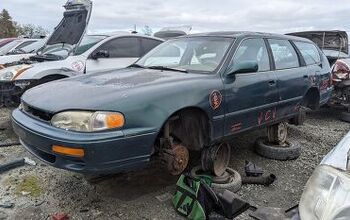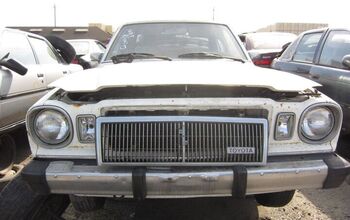Junkyard Find: 1980 Toyota Corolla Station Wagon

The fourth-generation Corolla was a gigantic sales success in California, but you won’t see many of these TE72 wagons even in rust-free regions these days; nearly all of them were driven into the ground and replaced by RAV4s or Priuses a decade or two back.
Since we had wagon Junkyard Finds on Monday and Wednesday, let’s make this a Junkyard Wagon Week with this third one!
The 3T engine was a 1,770cc pushrod unit that made just 70 horses in California-emissions-spec 3T-C form. On the plus side, the 3T sipped gas and was nearly impossible for even oil-change-deferring Americans to kill.
The drift kids like these cars, because they’re cheaper than the AE86 Corollas but are still rear-wheel-drive and can take a variety of stupid engine swaps (or stupid boost on the 3T-C).
This one is a longtime San Francisco Bay Area resident, with a 2001 Cal State Hayward (the name was changed to Cal State East Bay a few years ago, which was a real diss to the people of Hayward) sticker next to a bunch of $200-ticket-if-you-don’t-have-one City of Berkeley residential parking permits.
Yamaha, Kawasaki, and the San Francisco Opera all get bumper-sticker shout-outs, right next to the bought-from-a-street-vendor-on-Telegraph-Avenue-in-1983 QUESTION AUTHORITY sticker.
A 24 Hours of LeMons team is assembling a TE72 for the Arizona race next month, so I grabbed this car’s allegedly-hard-to-find distributor for them.
Even in Australia, the TE72 wagon was special.

Murilee Martin is the pen name of Phil Greden, a writer who has lived in Minnesota, California, Georgia and (now) Colorado. He has toiled at copywriting, technical writing, junkmail writing, fiction writing and now automotive writing. He has owned many terrible vehicles and some good ones. He spends a great deal of time in self-service junkyards. These days, he writes for publications including Autoweek, Autoblog, Hagerty, The Truth About Cars and Capital One.
More by Murilee Martin
Latest Car Reviews
Read moreLatest Product Reviews
Read moreRecent Comments
- W Conrad I'm not afraid of them, but they aren't needed for everyone or everywhere. Long haul and highway driving sure, but in the city, nope.
- Jalop1991 In a manner similar to PHEV being the correct answer, I declare RPVs to be the correct answer here.We're doing it with certain aircraft; why not with cars on the ground, using hardware and tools like Telsa's "FSD" or GM's "SuperCruise" as the base?Take the local Uber driver out of the car, and put him in a professional centralized environment from where he drives me around. The system and the individual car can have awareness as well as gates, but he's responsible for the driving.Put the tech into my car, and let me buy it as needed. I need someone else to drive me home; hit the button and voila, I've hired a driver for the moment. I don't want to drive 11 hours to my vacation spot; hire the remote pilot for that. When I get there, I have my car and he's still at his normal location, piloting cars for other people.The system would allow for driver rest period, like what's required for truckers, so I might end up with multiple people driving me to the coast. I don't care. And they don't have to be physically with me, therefore they can be way cheaper.Charge taxi-type per-mile rates. For long drives, offer per-trip rates. Offer subscriptions, including miles/hours. Whatever.(And for grins, dress the remote pilots all as Johnnie.)Start this out with big rigs. Take the trucker away from the long haul driving, and let him be there for emergencies and the short haul parts of the trip.And in a manner similar to PHEVs being discredited, I fully expect to be razzed for this brilliant idea (not unlike how Alan Kay wasn't recognized until many many years later for his Dynabook vision).
- B-BodyBuick84 Not afraid of AV's as I highly doubt they will ever be %100 viable for our roads. Stop-and-go downtown city or rush hour highway traffic? I can see that, but otherwise there's simply too many variables. Bad weather conditions, faded road lines or markings, reflective surfaces with glare, etc. There's also the issue of cultural norms. About a decade ago there was actually an online test called 'The Morality Machine' one could do online where you were in control of an AV and choose what action to take when a crash was inevitable. I think something like 2.5 million people across the world participated? For example, do you hit and most likely kill the elderly couple strolling across the crosswalk or crash the vehicle into a cement barrier and almost certainly cause the death of the vehicle occupants? What if it's a parent and child? In N. America 98% of people choose to hit the elderly couple and save themselves while in Asia, the exact opposite happened where 98% choose to hit the parent and child. Why? Cultural differences. Asia puts a lot of emphasis on respecting their elderly while N. America has a culture of 'save/ protect the children'. Are these AV's going to respect that culture? Is a VW Jetta or Buick Envision AV going to have different programming depending on whether it's sold in Canada or Taiwan? how's that going to effect legislation and legal battles when a crash inevitibly does happen? These are the true barriers to mass AV adoption, and in the 10 years since that test came out, there has been zero answers or progress on this matter. So no, I'm not afraid of AV's simply because with the exception of a few specific situations, most avenues are going to prove to be a dead-end for automakers.
- Mike Bradley Autonomous cars were developed in Silicon Valley. For new products there, the standard business plan is to put a barely-functioning product on the market right away and wait for the early-adopter customers to find the flaws. That's exactly what's happened. Detroit's plan is pretty much the opposite, but Detroit isn't developing this product. That's why dealers, for instance, haven't been trained in the cars.
- Dartman https://apnews.com/article/artificial-intelligence-fighter-jets-air-force-6a1100c96a73ca9b7f41cbd6a2753fdaAutonomous/Ai is here now. The question is implementation and acceptance.




















































Comments
Join the conversation
I owned a bunch of Toyotas throughout the 90's including a Corona, two Celicas, and a couple of these - one just like the one in the photos (!), and one two-door SR-5 Liftback in that burnt orange color that they sold so many of them in: bit.ly/20ZNpLC. I will always love that SR-5. Despite being a rag bag, it is to this day my favorite car that I've ever owned. It had excellent weight distribution, a 5-speed and you could tach it until the valves floated. I would tear down twisty dirt roads in the boonies at ridiculous speeds, and let the tail hang out at every opportunity. The rust cancer finally got it - it went to the junkyard still running. By the way, being the favorite car I've ever owned is no joke. I've had cars from every automaker and decade from 1970 to the present. This includes many years of BMW's including a couple of E30s (one a swap car) and an E36, a heavily modified AMG Mercedes-Benz, and a host of American muscle. I still wish I had that SR-5. Only not as a tired rust heap.
Hope you got some shots of that first-gen Integra next to the Corolla. I have great memories of mine.